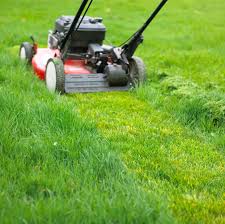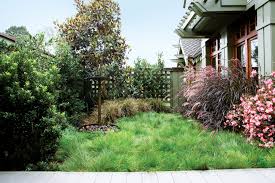Mowing grass is a crucial task in maintaining a healthy and vibrant lawn. Regularly cutting the grass helps to keep it at an optimal height, promoting strong growth and a neat appearance. Proper mowing techniques not only enhance the aesthetic appeal of your outdoor space but also contribute to the overall health of your lawn.
When you mow grass, it’s essential to follow a few basic guidelines to achieve the best results. First, make sure your lawnmower’s blades are sharp. Dull blades can tear the grass instead of cleanly cutting it, leading to a ragged look and potential damage to the grass blades. Sharpening the blades at the beginning of the mowing season and periodically throughout is advisable.
Next, choose the right mowing height. Different types of grass have different ideal heights. Generally, it’s recommended to remove only about one-third of the grass height in a single mowing session. Cutting too much at once can stress the grass and leave it susceptible to diseases and weed invasion. Regular mowing prevents the grass from becoming too tall, which can create shade and encourage weed growth.
Avoid mowing when the grass is wet. Wet grass can clog the lawnmower and create uneven cuts. It’s best to mow when the grass is dry to ensure a cleaner and more even cut. Additionally, vary your mowing pattern with each session. Changing the direction in which you mow helps prevent the grass from leaning in one direction and promotes upright growth.
Clippings left on the lawn after mowing can be beneficial. They decompose and provide natural nutrients back to the soil, acting as a natural fertilizer. This practice is known as “grasscycling.” However, if the clippings are too long, they may need to be collected to prevent clumping.
In addition, mowing grass is a task that requires attention to detail and proper techniques. By using sharp blades, mowing at the correct height, avoiding wet grass, changing mowing patterns, and considering grasscycling, you can ensure a lush and healthy lawn that enhances the beauty of your outdoor space. Regular mowing not only keeps your lawn looking its best but also contributes to its overall well-being.
Read Also: All You Need To Know About Greener Grass
Techniques used in Mowing Grass

Achieving a healthy and well-maintained lawn involves more than just cutting the grass. Proper mowing techniques play a crucial role in promoting lush growth, preventing damage, and enhancing the overall appearance of your lawn. Here are some essential Mowing techniques to keep in mind:
1. Sharp Blades Matter: Start with sharp lawnmower blades. Dull blades can tear the grass, leading to an uneven cut and increased stress on the lawn. Sharpen your mower blades at the beginning of the mowing season and as needed.
2. Mowing Height Matters: Adjust the mowing height based on your grass type. Different grass varieties have different ideal heights. Generally, avoid cutting more than one-third of the grass height in a single session to prevent stress.
3. Mow When It’s Dry: Mow when the grass is dry. Wet grass can clog the mower deck, result in uneven cuts, and promote the spread of diseases.
4. Change Mowing Patterns: Vary the direction you mow with each session. Alternating patterns helps prevent grass from leaning in one direction and encourages upright growth.
5. Mulch or Bag Clippings: Consider grasscycling by leaving clippings on the lawn. They decompose and provide natural nutrients. If clippings are too long, use a bag attachment to collect and dispose of them properly.
6. Avoid Scalping: Scalping, or cutting the grass too short, can stress the lawn and expose soil to sunlight, leading to weed growth. Maintain a consistent mowing height to prevent scalping.
7. Trim Edges and Borders: Pay attention to edges, borders, and hard-to-reach areas. Use a trimmer or edger to create clean lines and prevent overgrowth.
8. Mowing Frequency: Adjust mowing frequency based on grass growth. During periods of rapid growth, you may need to mow more often. In slower growth periods, you can mow less frequently.
9. Cooler Mowing Times: Mow during cooler parts of the day, such as early morning or late afternoon. Mowing during the heat of the day can stress the grass and lead to moisture loss.
10. Maintain Your Mower: Regularly service your lawnmower. Clean the deck, check oil levels, and replace air filters as needed.
11. Striping Techniques (Optional): For a unique visual effect, you can achieve striping patterns on your lawn by mowing in alternating directions. This technique can create a professional and decorative appearance.
By mastering these mowing techniques, you’ll not only ensure a healthier and more vibrant lawn but also enjoy the satisfaction of a well-groomed outdoor space that enhances your home’s curb appeal.
Benefits of Mow Grass
Here are seven good benefits of proper mowing practices for your lawn:
1. Healthy Growth: Regular mowing at the appropriate height prevents the grass from becoming too tall and shades the soil, promoting healthy growth and lush, dense turf.
2. Weed Control: Keeping the grass at the right height helps shade out weed seeds, reducing the likelihood of weed growth and competition with your desired grass.
3. Enhanced Appearance: Proper mowing gives your lawn a neat and well-maintained look, boosting the overall aesthetic appeal of your outdoor space.
4. Strong Root System: Consistent mowing encourages the grass to develop a robust root system, improving its ability to absorb water and nutrients from the soil.
5. Reduced Pest and Disease Risk: Regular mowing minimizes potential hiding spots for pests and reduces moisture on the grass blades, helping to prevent the spread of diseases.
6. Improved Stress Tolerance: Well-maintained lawns are better equipped to handle environmental stresses like drought, heat, and foot traffic due to their healthier growth patterns.
7. Environmental Benefits: Grasscycling, or leaving grass clippings on the lawn, adds nutrients back to the soil naturally, reducing the need for synthetic fertilizers and benefiting the environment.
By following proper mowing techniques and recognizing these benefits, you can ensure a vibrant, thriving lawn that becomes a source of pride and enjoyment for you and your family.
Read Also: The Different Crop Storage Methods
No Mow Grass

In the realm of sustainable landscaping and low-maintenance outdoor solutions, “No Mow Grass” has emerged as a revolutionary concept that challenges traditional notions of manicured lawns. This innovative approach offers a range of benefits, both for homeowners and the environment, by redefining the way we think about green spaces.
No Mow Grass, as the name suggests, involves using specially selected grass varieties that require minimal or no mowing. These grasses typically grow at a slower rate and maintain a shorter stature, eliminating the need for frequent mowing sessions. This approach not only saves time and effort but also offers a host of other advantages.
One of the most significant benefits of No Mow Grass is its ecological impact. Traditional lawns often demand significant water consumption to stay green, especially during hot and dry periods. No Mow Grass, on the other hand, is often drought-tolerant and thrives with minimal irrigation. This conservation of water resources contributes to water savings and reduces the strain on local water supplies.
Beyond water conservation, No Mow Grass also plays a role in promoting biodiversity. These grasses can create natural habitats for insects, birds, and other wildlife. The lower mowing frequency allows flowers and native plants to flourish, attracting pollinators and contributing to a healthier ecosystem.
Additionally, No Mow Grass can significantly reduce the use of chemical fertilizers and pesticides. By embracing the natural growth patterns of these grasses, homeowners can decrease their reliance on synthetic inputs that can harm the environment and potentially impact human health.
From a practical standpoint, No Mow Grass offers homeowners a versatile and sustainable landscaping option. It’s well-suited for areas that are difficult to access with traditional lawnmowers, such as slopes, embankments, or small spaces. Its low-maintenance nature means less time spent on mowing and more time enjoying the outdoors.
No Mow Grass doesn’t mean sacrificing beauty or visual appeal. Many varieties of No Mow Grass showcase unique textures, colors, and forms that can create a visually stunning landscape. Whether you’re seeking a natural and wild meadow-like look or a contemporary, minimalist aesthetic, No Mow Grass provides options to suit various design preferences.
In conclusion, No Mow Grass represents a paradigm shift in landscaping philosophy. By embracing the beauty of less conventional grass growth, homeowners can enjoy a range of benefits that extend beyond their property boundaries. This eco-friendly and practical approach not only saves time and resources but also contributes to a healthier environment and a more harmonious coexistence with nature.
Read Also: Why Proper Infant Footwears are Essential for Your Baby’s Development
